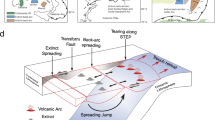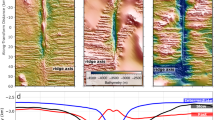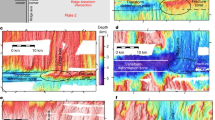Abstract
SEGMENTATION by transform faults and other types of along-axis discontinuity1 is a well described but poorly explained characteristic of oceanic spreading centres. Here we use numerical experiments to explore the dynamics of mantle flow and melting beneath a mid-ocean ridge. Buoyant upwelling, driven by compositional density variations resulting from the extraction of the melt that forms the ocean crust, exhibits a spreading-rate-dependent transition between two-dimensional and three-dimensional upwelling structures. For low spreading rates and mantle viscosities an initial two-dimensional structure transforms into a three-dimensional one; at high spreading rates, an initially two-dimensional structure remains two-dimensional. These results suggest that the origin of spreading-centre segmentation may be different at fast and slow spreading rates.
This is a preview of subscription content, access via your institution
Access options
Subscribe to this journal
Receive 51 print issues and online access
$199.00 per year
only $3.90 per issue
Buy this article
- Purchase on Springer Link
- Instant access to full article PDF
Prices may be subject to local taxes which are calculated during checkout
Similar content being viewed by others
References
Sempere, J. C. & Macdonald, K. C. Rev. Geophys. 25, 1313–1347 (1987).
Whitehead, J. A., Dick, H. J. B. & Schouten, H. Nature 312, 146–147 (1984).
Crane, K. Earth planet Sci. Lett. 72, 405–414 (1985).
Kuo, B. Y. & Forsyth, D. W. Mar. geophys. Res. 10, 205–232 (1988).
Lin, J., Purdy, G. M., Schouten, H., Sempere, J-C. & Zervas, C. Nature 344, 627–632 (1990).
Phipps Morgan, J. & Forsyth, D. W. J. geophys. Res. 93, 2955–2966 (1988).
Rabinowicz, M., Ceuleneer, G. & Nicolas, A. J. geophys. Res. 92, 3475–3485 (1987).
Buck, W. R. & Su, W. Geophys. Res. Lett. 16, 641–644 (1989).
Scott, D. R., & Stevenson, D. J. J. geophys. Res. 94, 2973–2988 (1989).
Sotin, C. & Parmentier, E. M. Geophys. Res. Lett. 16, 835–838 (1989).
Daines, M. J. & Richter, F. M. Geophys. Res. Lett. 15, 1459–1462 (1988).
Riley, G. N. Jr. Kohlstedt, D. A. & Richter, F. M. Eos 71, 627 (1990).
Ahern, J. L., & Turcotte, D. L. Earth planet. Sci. Lett. 45, 115–122 (1979).
Phipps Morgan, J. Geophys. Res. Lett. 14, 1238–1241 (1987).
Sleep, N. H. J. geophys. Res. 93, 10255–10272 (1988).
Oxburgh, E. R. & Parmentier, E. M. J. geol. Soc. Lond. 133, 343–354 (1977).
Jordan, T. H., Proc. 2nd Int. Kimberlite Conf. Vol. 2 (eds Boyd, F. R. & Meyer, H. O. A.) (Am. geophys. Un., Washington, DC, 1979).
Reid, I. & Jackson, H. R. Mar. geophys. Res. 5, 165–172 (1981).
Author information
Authors and Affiliations
Rights and permissions
About this article
Cite this article
Parmentier, E., Morgan, J. Spreading rate dependence of three-dimensional structure in oceanic spreading centres. Nature 348, 325–328 (1990). https://doi.org/10.1038/348325a0
Received:
Accepted:
Issue Date:
DOI: https://doi.org/10.1038/348325a0
This article is cited by
-
Broad fault zones enable deep fluid transport and limit earthquake magnitudes
Nature Communications (2023)
-
Uppermost crustal structure across the eastern Lau spreading center from P-to-S converted waves
Marine Geophysical Research (2020)
-
The initiation of segmented buoyancy-driven melting during continental breakup
Nature Communications (2016)
-
Convective upwelling in the mantle beneath the Gulf of California
Nature (2009)
-
Skew of mantle upwelling beneath the East Pacific Rise governs segmentation
Nature (2007)
Comments
By submitting a comment you agree to abide by our Terms and Community Guidelines. If you find something abusive or that does not comply with our terms or guidelines please flag it as inappropriate.



